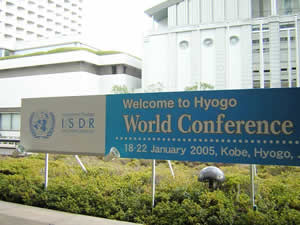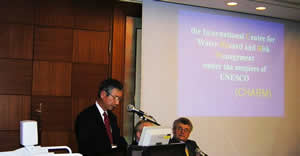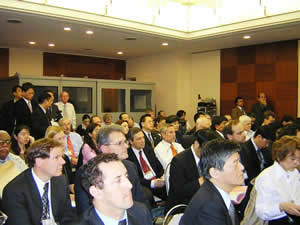|

International
Conference Center Kobe and Kobe Portopia Hotel, at which
the conference was held. Located about 15 minutes from
JR Sannomiya Station by Portliner train.

Dr.
Sakamoto, Chief Executive of PWRI, explaining the preparatory
activities for ICHARM as part of his opening words.

The
room with a capacity of about 60 people remained full
for two hours, until the end of the meeting.
|
The
United Nations World Conference on Disaster Reduction
(WCDR) was held from Tuesday, January 18 through Saturday,
January 22 at the International Conference Center Kobe
and its adjoining hotel, Kobe Portopia Hotel. The conference
was held exactly a decade after the Great Hanshin-Awaji
Earthquake occurred in January 17, 1995. In commemoration
of the 10th year after the quake, one of the major themes
was to learn useful lessons for the future by reflecting
on how the restoration has progressed. In December 2004,
about a month before the conference, the Sumatra Earthquake
and consequent Indian Ocean Tsunami Disaster caused
tremendous damage to a number of countries in the region.
The disaster called for an urgent meeting to talk about
countermeasures and plans to build an international
cooperation and coordination system for tsunami disaster
prevention, including the establishment of early warning
mechanism. Under such circumstances, the conference
drew a great deal of media attention throughout the
period and was reported as a top news item. The conference
was organized by the Secretariat of the International
Strategy for Disaster Reduction (ISDR), a Geneva-based
organization, with cooperation of related UN agencies
and there were a total of more than 4,000 participants
from a broad range of international organizations and
non-governmental organizations (NGOs), such as governmental
organizations from 168 countries, the United Nations
Educational, Scientific and Cultural Organization (UNESCO),
and the World Meteorological Organization (WMO). The
conference provided three different types of meetings,
and more than ten meetings were held simultaneously
at the conference center and hotel. In some meetings,
governmental officials of the participating countries
got together and worked on consensus documents for every
member country to agree upon. Other meetings include
theme specific sessions to discuss, and provided additional
opinions and information to support the results of the
meetings among governmental officials. There were still
other meetings, so-called "public forums",
where not only experts but also the general public could
participate to voice their opinions.
The Public Works Research Institute (PWRI) co-hosted
a theme specific session entitled "Research on
Floods and Landslides and A New International Initiative
for Risk Reduction" (16:30-18:30, January 19) with
UNESCO and WMO. In the beginning of the session, chaired
by Prof. Ginkel, President of United Nations University,
the Chief Executive of PWRI, Dr. Sakamoto, explained
the preparatory activities for ICHARM (International
Center for Water Hazard and Risk Management under the
auspices of UNESCO) as part of his opening words, accompanied
by Dr. Matsuura, Secretary-General of UNESCO, Dr. Jeraud,
Secretary-General of WMO and Prof. Inoue, Director of
the Disaster Prevention Research Institute, Kyoto University.
In the first half of the session, Mr. Terakawa introduced
the discussion topic by giving the presentation entitled
"Comprehensive Flood Risk Management and the Role
of ICHARM" The official launch of the International
Flood Initiative (IFI) was also declared in this session.
IFI is an international initiative of inter-organ efforts
at the global level and is expected to contribute to
flood disaster prevention and reduction. ICHARM is scheduled
to make an official start in 2005 and is expected to
be a global facility contributing to the Initiative.
Senior Researcher Yoshitani of the Secretariat for Preparatory
Activities of ICHARM is nominated as a member of an
IFI task force that is responsible for preparing a draft
action plan of the Initiative.
The River Bureau of the Ministry of National Land, Infrastructure
and Transport (MLIT) co-hosted a theme specific session
entitled "Knowledge Sharing and Comprehensive Flood
Risk Management through Educational Training" (17:15-19:15,
January 20) with WMO and the Australian Bureau of Meteorology
(BOM). Mr. Terakawa co-chaired the session with Mr.
Bruce Stewart, Deputy-Director of BOM. After seven presentations
and the discussion following, the session suggested
in its proposal that ICHARM should play a role in research
and training in order to transfer technologies for flood
disaster reduction to developing countries.
On the last day of the conference (January 22), based
on the results of each meeting held up to the day before,
"The Hyogo Declaration" and "The Hyogo
Framework for Action" were concluded as the final
achievement of the conference. It was clearly stated
in those official announcements that disaster prevention
and reduction should be strategically addressed in cooperation
with countries throughout the world. Sharing the same
understanding that each country is primarily responsible
for sustainable development, and the lives and properties
of their own people, the participatory countries agreed
on five specific actions that should be given priority
over the next ten years (2005-2015). Each country should:
1) Ensure that disaster risk reduction is a national
and local priority with a strong institutional basis
for implementation; 2) Identify, assess and monitor
disaster risks and enhance early wanring; 3) Use knowledge,
innovation and education to build a culture of safety
and resilience at all levels; 4) Reduce the underlying
risk factors; 5) Strengthen disaster preparedness for
effective response. ICHARM especially focuses on the
second and third among the five priority actions, and
will make concrete contributions to "building disaster-resistant
communities and countries" from a global perspective. |